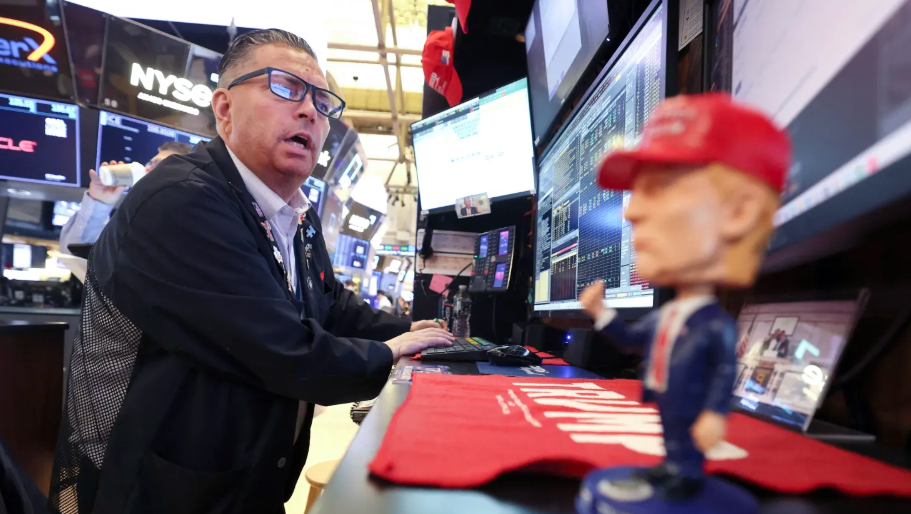Stocks slide as Trump targets Fed Chair Powell

By MG News | April 22, 2025 at 09:54 AM GMT+05:00
April 22, 2025 (MLN): Stocks fell again as President Donald Trump ramped up his attacks on Federal Reserve Chair Jerome Powell, raising questions about the central bank’s independence, while traders received few signs of progress on global trade talks.
The Dow Jones Industrial Average dropped 971.82 points, or 2.48% to close at 38,170.41.
The S&P 500 shed 2.36% and ended at 5,158.20, and the Nasdaq Composite lost 2.55% to settle at 15,870.90.
“Magnificent Seven” tech titans dragged the major indexes lower, with Tesla and Nvidia respectively losing 5.8% and more than 4%.
Amazon shed 3%, as did Meta Platforms. Equipment manufacturer Caterpillar declined 2.8%.
In a Truth Social post, Trump claimed that the economy would slow unless Powell who he referred to as “Mr. Too Late, a major loser” lowered interest rates immediately.
This follows another post last week in which Trump also called for the Fed to lower rates, even hinting at Powell’s “termination” something White House economic advisor Kevin Hassett said the president’s team was studying.
The dollar was also under pressure, hitting a three-year low as the threats ramped up. Gold, meanwhile, soared to record highs above $3,400 per ounce.
“One of the things that is becoming very clear is the underlying tension between the Fed and the administration,” said Michael Green, chief strategist of Simplify Asset Management.
“We are effectively in a replay of COVID. The uncertainty has meaningfully disrupted trade ... I think most people anticipate that there will be some form of stimulus that ultimately emerges to offset the effects of the tariff.”
Investor confidence was also dented by a lack of progress on global trade.
If anything, tensions seemed to increase with China with the country warning other nations not to strike any deal with the U.S. that would hurt Beijing.
The S&P 500 is down 9% since April 2, when Trump announced a raft of levies on imports from other countries.
The Nasdaq has lost nearly 10% in that time, and the Dow has fallen 9.6%.
“We’re really thinking about this as a bit of an endless environment in terms of direction ... and that’s in particular because we just don’t know where tariffs end up,” said Robert Haworth, senior investment strategist at U.S. Bank, in an interview with CNBC.
“This is a market trying to get clarity on direction, and not getting a lot of conclusions.”
Haworth added: “If uncertainty continues for an extended period of time meaning multiple quarters I think that becomes more challenging for corporate earnings and decision making, and we’ve seen some of that in the earnings season so far.”
Stocks ended Monday in the red, although they came back from their session lows in the late afternoon, as CNBC reported.
The Dow Jones Industrial Average tumbled 971.82 points, or 2.48%, to settle at 38,170.41.
The S&P 500 shed 2.36% to finish at 5,158.20, while the Nasdaq Composite lost 2.55% and closed at 15,870.9.
Oppenheimer chief investment strategist John Stoltzfus remains positive on equities, he wrote in a Monday note.
“Pullbacks earlier this year have mostly looked like ‘trims’ and ‘haircuts’ for the S&P 500 whenever bears, skeptics, and nervous investors have found a catalyst to take near-term profits,” he wrote.
“This has happened without FOMO (fear of missing out), amid what appears to us in fundamentals that persist in showing resilience like a very much intact bull market.”
Stoltzfus added: “Drivers of the bull market that in our view have provided resilience in the intermittent downdrafts that occurred in 2024 into this year include the success the Fed has had in pursuing tighter monetary policy that has brought down the pace of inflation since March of 2022.”
He noted this has been aided by resilience in consumer spending, S&P 500 earnings growth, and job growth, which have provided support for the US economy and the markets.
The strategist listed his favorite sectors as information technology, financials, industrials, consumer discretionary and communications services.
In a Monday note, Telsey Advisory Group CEO and chief research officer Dana Telsey shared a list of current market must-haves.
“Given this uncertain, mercurial backdrop, we divide the consumer segments into the Haves those companies with a better ability to deliver sales and earnings given their greater focus on essentials,” she wrote.
“The Have-Nots are those companies that generate sales and profits from a more discretionary offering, which can be delayed in this environment,” she added.
Companies that fell into the “haves” bucket included big box discounters such as Costco and Walmart, as well as grocery stores, off-price stores and brand leaders.
On the other hand, department stores, luxury firms and home-related retailers made up the have-nots.
While U.S. stocks have certainly taken a beating in the past few weeks, Trivariate Research wrote that “this is not the end of U.S. exceptionalism” in a Sunday note.
“There is a large and growing cohort of people that now think the U.S. equity market will be inferior to non-US equity markets for the foreseeable future, and at a recent CIO dinner in New York, our pro-U.S. stance was in the minority,” wrote founder Adam Parker.
Parker listed several reasons for this viewpoint, such as lower near-term U.S. population and economic growth, less potential innovation in U.S. universities, more monetary policy accommodation in Europe.
“But the other logic that is consistently used is that the U.S. is more expensive, which we find amusing since the U.S. has been more expensive than most other markets the entire time it massively outperformed."
"Our judgment is that what is happening is typical, which is that near-term price movement has impacted sentiment,” Parker added.
The U.S. markets have been performing worse than every major market so far this year.
After the fact, many investors are now saying this is the beginning of a new long-term trend.
"We disagree, and our view is that this dynamic of U.S. underperformance likely lasts less than one year,” Parker noted
Gold prices broke $3,400 on Monday, hitting a new record as President Donald Trump’s threats against the Federal Reserve’s independence and his tariffs shake investor confidence in the U.S. economy.
Gold futures jumped 2.91% to close at $3,425.30 per ounce, with investors buying the precious metal as the dollar hit a three-year low.
The president ramped up pressure on Fed Chair Jerome Powell on Monday, calling him a “major loser” and demanding that the central bank lower interest rates now.
Citi sees gold prices rallying to $3,500 over the next three months as investment demand outstrips supply from mining.
Copyright Mettis Link News
Related News
| Name | Price/Vol | %Chg/NChg |
|---|---|---|
| KSE100 | 125,627.31 258.99M |
1.00% 1248.25 |
| ALLSHR | 78,584.71 1,142.41M |
1.16% 904.89 |
| KSE30 | 38,153.79 69.25M |
0.63% 238.06 |
| KMI30 | 184,886.50 91.38M |
0.01% 13.72 |
| KMIALLSHR | 53,763.81 554.57M |
0.54% 290.61 |
| BKTi | 31,921.68 33.15M |
1.78% 557.94 |
| OGTi | 27,773.98 9.65M |
-0.40% -112.21 |
| Symbol | Bid/Ask | High/Low |
|---|
| Name | Last | High/Low | Chg/%Chg |
|---|---|---|---|
| BITCOIN FUTURES | 107,590.00 | 107,860.00 107,555.00 |
-645.00 -0.60% |
| BRENT CRUDE | 66.63 | 67.20 65.92 |
-0.17 -0.25% |
| RICHARDS BAY COAL MONTHLY | 97.00 | 97.00 97.00 |
1.05 1.09% |
| ROTTERDAM COAL MONTHLY | 107.65 | 107.65 105.85 |
1.25 1.17% |
| USD RBD PALM OLEIN | 998.50 | 998.50 998.50 |
0.00 0.00% |
| CRUDE OIL - WTI | 64.95 | 65.02 64.83 |
-0.16 -0.25% |
| SUGAR #11 WORLD | 16.19 | 16.74 16.14 |
-0.52 -3.11% |
Chart of the Day
Latest News
Top 5 things to watch in this week
Pakistan Stock Movers
| Name | Last | Chg/%Chg |
|---|
| Name | Last | Chg/%Chg |
|---|



